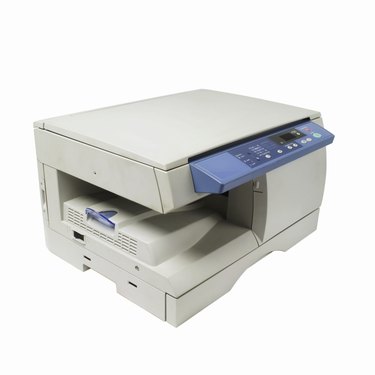Things You'll Need
Copy machine
Digital camera
Masking tape
Tracing paper, 1 sheet, 5 inches by 5 inches
Pencil
Pencil sharpener
Carpenter's pencil, 6B
Paper towel, 1 sheet
4-1/4- by 4-1/4-inch white ceramic bisque tile

Transferring your art to a ceramic tile so it can be glazed and fired is a simple process. Artists like Michelangelo have been using transfer techniques for centuries. Transferring designs and painting them on tiles is very similar to the process of drawing and painting on a canvas, except in this case, your canvas is a ceramic tile. All you have to do is make a "cartoon" line drawing from your art, transfer it to the tile, paint it with glazes and fire it in a kiln—and voila—your artwork has miraculously been transferred to a tile.
Step 1
Reduce your art to fit the 4-1/4- by 4-1/4-inch tile. If your original art is larger than the 4-1/4- by 4-1/4-inch tile, simply take it to a copy center and reduce it to fit the tile's dimensions. If your original art is larger than the bed of a copy machine (usually 11 inches by 17 inches is the largest size) then photograph your design with your digital camera, import it into your computer photo enhancement program and resize it to fit the dimensions of the tile.
Video of the Day
Step 2
Tape the reduced art onto a work table. Place the 5- by 5-inch translucent tracing paper sheet over the artwork and tape it down.
Step 3
Take a sharp pencil and make a detailed line drawing of your artwork on the tracing paper.
Step 4
Lift the tracing paper with the finished line drawing off the work surface, and remove the tape.
Step 5
Flip the tracing paper over and with the carpenter's pencil, fill in the entire back of the tracing paper with graphite making sure to cover all the design lines.
Step 6
Take the paper towel and smudge the graphite on the back of the tracing paper so it creates an even overall surface of graphite powder.
Step 7
Tape the back of the tile by "looping" pieces of masking tape and applying them to the four corners of the back. Flip the tile over and press the tile onto a work table, making sure it is securely in place and will not move. Attach masking tape to the sides of the tile to secure it further.
Step 8
Place the tracing paper design with the drawing side up and the graphite side facing down and position the design properly over the tile so it will be transferred onto it perfectly.
Step 9
Pressing down firmly on the pencil, draw over the lines of your original tracing. The drawing will transfer onto the bisque tile through the graphite backed tracing paper. Remove the tracing paper when finished. Apply colored glazes to complete the art on the tile and fire it in the kiln to finish the process.
Tip
Carpenter's pencils have wide, chiseled leads that make them ideal for filling in large areas on drawing or tracing papers.
Bisque tiles are tiles that have been fired once, and do not have a glossy surface, which makes them receptive to pencil marks and glaze paints.
Make sure to sharpen several pencils before starting, so there is no interruption to the drawing process.
Video of the Day